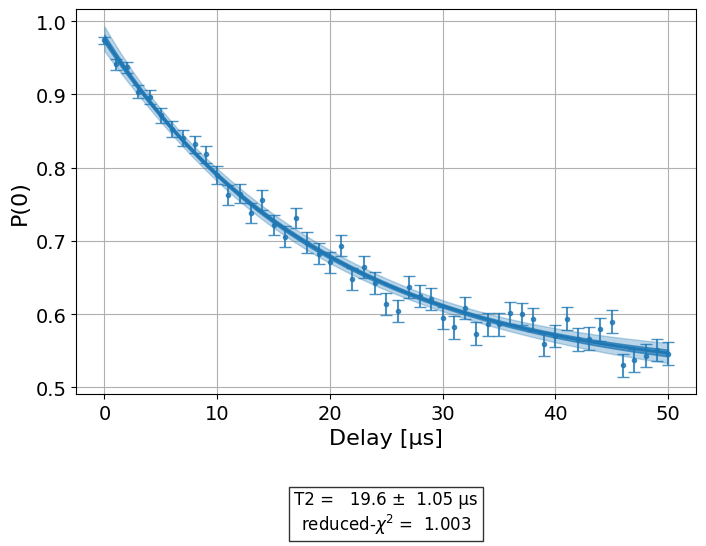Note
This is the documentation for the current state of the development branch of Qiskit Experiments. The documentation or APIs here can change prior to being released.
T2Hahn¶
- class T2Hahn(physical_qubits, delays, num_echoes=1, backend=None)[source]¶
An experiment to measure the dephasing time insensitive to inhomogeneous broadening using Hahn echos.
Overview
This experiment is used to estimate the \(T_2\) time of a single qubit. \(T_2\) is the dephasing time or the transverse relaxation time of the qubit on the Bloch sphere as a result of both energy relaxation and pure dephasing in the transverse plane. Unlike \(T_2^*\), which is measured by
T2Ramsey, \(T_2\) is insensitive to inhomogenous broadening.This experiment consists of a series of circuits of the form
┌─────────┐┌──────────┐┌───────┐┌──────────┐┌─────────┐┌─┐ q_0: ┤ Rx(π/2) ├┤ DELAY(t) ├┤ RX(π) ├┤ DELAY(t) ├┤ RX(π/2) ├┤M├ └─────────┘└──────────┘└───────┘└──────────┘└─────────┘└╥┘ c: 1/════════════════════════════════════════════════════════╩═ 0for each t from the specified delay times and the delays are specified by the user. The delays that are specified in the experiment options and the delay in the metadata both represent the sum of all delay gates in the circuit.
References
[1] Philip Krantz, Morten Kjaergaard, Fei Yan, Terry P. Orlando, Simon Gustavsson, William D. Oliver, A Quantum Engineer’s Guide to Superconducting Qubits, Applied Physics Reviews 6, 021318 (2019), doi: 10.1063/1.5089550 (open)
User manual
Analysis class reference
Experiment options
These options can be set by the
set_experiment_options()method.- Options
Defined in the class
T2Hahn:delays (Iterable[float])
Default value:NoneDelay times of the experiments.num_echoes (int)
Default value:1The number of echoes to preform.
Defined in the class
BaseExperiment:max_circuits (Optional[int])
Default value:NoneThe maximum number of circuits per job when running an experiment on a backend.
Example
import numpy as np from qiskit_experiments.library.characterization.t2hahn import T2Hahn delays = np.linspace(0, 50e-6, 11) exp = T2Hahn(physical_qubits=(0, ), delays=delays, backend=backend) exp.analysis.set_options(p0=None, plot=True) exp_data = exp.run().block_for_results() display(exp_data.figure(0)) exp_data.analysis_results(dataframe=True)

name experiment components value quality backend run_time chisq unit d954d221 T2 T2Hahn [Q0] (2.03+/-0.21)e-05 good T2Hahn_simulator None 0.784584 s Initialization
Initialize the T2 - Hahn Echo class.
- Parameters:
physical_qubits (Sequence[int]) – a single-element sequence containing the qubit whose T2 is to be estimated.
delays (List[float] | array) – Total delay times of the experiments.
backend (Backend | None) – Optional, the backend to run the experiment on.
num_echoes (int) – The number of echoes to preform.
backend – Optional, the backend to run the experiment on.
- Raises:
QiskitError – Error for invalid input.
Attributes
- analysis¶
Return the analysis instance for the experiment
- backend¶
Return the backend for the experiment
- experiment_options¶
Return the options for the experiment.
- experiment_type¶
Return experiment type.
- num_qubits¶
Return the number of qubits for the experiment.
- physical_qubits¶
Return the device qubits for the experiment.
Methods
- circuits()[source]¶
Return a list of experiment circuits.
Each circuit consists of RX(π/2) followed by a sequence of delay gate, RX(π) for echo and delay gate again. The sequence repeats for the number of echoes and terminates with RX(±π/2).
- Returns:
The experiment circuits.
- Return type:
List[QuantumCircuit]
- config()¶
Return the config dataclass for this experiment
- Return type:
- copy()¶
Return a copy of the experiment
- Return type:
- classmethod from_config(config)¶
Initialize an experiment from experiment config
- Return type:
- job_info(backend=None)¶
Get information about job distribution for the experiment on a specific backend.
- Parameters:
backend (Backend) – Optional, the backend for which to get job distribution information. If not specified, the experiment must already have a set backend.
- Returns:
A dictionary containing information about job distribution.
”Total number of circuits in the experiment”: Total number of circuits in the experiment.
”Maximum number of circuits per job”: Maximum number of circuits in one job based on backend and experiment settings.
”Total number of jobs”: Number of jobs needed to run this experiment on the currently set backend.
- Return type:
dict
- Raises:
QiskitError – if backend is not specified.
- run(backend=None, sampler=None, analysis='default', timeout=None, backend_run=None, **run_options)¶
Run an experiment and perform analysis.
- Parameters:
backend (Backend | None) – Optional, the backend to run on. Will override existing backend settings.
sampler (BaseSamplerV2 | None) – Optional, the sampler to run the experiment on. If None then a sampler will be invoked from previously set backend
analysis (BaseAnalysis | None) – Optional, a custom analysis instance to use for performing analysis. If None analysis will not be run. If
"default"the experimentsanalysis()instance will be used if it contains one.timeout (float | None) – Time to wait for experiment jobs to finish running before cancelling.
backend_run (bool | None) – Use backend run (temp option for testing)
run_options – backend runtime options used for circuit execution.
- Returns:
The experiment data object.
- Raises:
QiskitError – If experiment is run with an incompatible existing ExperimentData container.
- Return type:
- set_experiment_options(**fields)¶
Set the experiment options.
- Parameters:
fields – The fields to update the options
- Raises:
AttributeError – If the field passed in is not a supported options
- set_run_options(**fields)¶
Set options values for the experiment
run()method.- Parameters:
fields – The fields to update the options
See also
The Setting options for your experiment guide for code example.
- set_transpile_options(**fields)¶
Set the transpiler options for
run()method.- Parameters:
fields – The fields to update the options
- Raises:
QiskitError – If initial_layout is one of the fields.
See also
The Setting options for your experiment guide for code example.